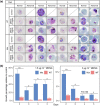Analysis of genome instability and implications for the consequent phenotype in Plasmodium falciparum containing mutated MSH2-1 (P513T)
- PMID: 37083479
- PMCID: PMC10210953
- DOI: 10.1099/mgen.0.001003
Analysis of genome instability and implications for the consequent phenotype in Plasmodium falciparum containing mutated MSH2-1 (P513T)
Abstract
Malarial parasites exhibit extensive genomic plasticity, which induces the antigen diversification and the development of antimalarial drug resistance. Only a few studies have examined the genome maintenance mechanisms of parasites. The study aimed at elucidating the impact of a mutation in a DNA mismatch repair gene on genome stability by maintaining the mutant and wild-type parasites through serial in vitro cultures for approximately 400 days and analysing the subsequent spontaneous mutations. A P513T mutant of the DNA mismatch repair protein PfMSH2-1 from Plasmodium falciparum 3D7 was created. The mutation did not influence the base substitution rate but significantly increased the insertion/deletion (indel) mutation rate in short tandem repeats (STRs) and minisatellite loci. STR mutability was affected by allele size, genomic category and certain repeat motifs. In the mutants, significant telomere healing and homologous recombination at chromosomal ends caused extensive gene loss and generation of chimeric genes, resulting in large-scale chromosomal alteration. Additionally, the mutant showed increased tolerance to N-methyl-N'-nitro-N-nitrosoguanidine, suggesting that PfMSH2-1 was involved in recognizing DNA methylation damage. This work provides valuable insights into the role of PfMSH2-1 in genome stability and demonstrates that the genomic destabilization caused by its dysfunction may lead to antigen diversification.
Keywords: MutS homologue 2; PfMSH2-1; Plasmodium falciparum; malaria; mutation accumulation test; mutator.
Conflict of interest statement
The author declares that there are no conflicts of interest.
Figures




Similar articles
-
The role of DNA mismatch repair in generating genetic diversity and drug resistance in malaria parasites.Mol Biochem Parasitol. 2007 Sep;155(1):18-25. doi: 10.1016/j.molbiopara.2007.05.003. Epub 2007 May 13. Mol Biochem Parasitol. 2007. PMID: 17583362 Free PMC article.
-
Chromosome End Repair and Genome Stability in Plasmodium falciparum.mBio. 2017 Aug 8;8(4):e00547-17. doi: 10.1128/mBio.00547-17. mBio. 2017. PMID: 28790200 Free PMC article.
-
OTUB1 stabilizes mismatch repair protein MSH2 by blocking ubiquitination.J Biol Chem. 2021 Jan-Jun;296:100466. doi: 10.1016/j.jbc.2021.100466. Epub 2021 Feb 26. J Biol Chem. 2021. PMID: 33640455 Free PMC article.
-
Genetic and genomic basis of the mismatch repair system involved in Lynch syndrome.Int J Clin Oncol. 2019 Sep;24(9):999-1011. doi: 10.1007/s10147-019-01494-y. Epub 2019 Jul 4. Int J Clin Oncol. 2019. PMID: 31273487 Review.
-
Disease-associated repeat instability and mismatch repair.DNA Repair (Amst). 2016 Feb;38:117-126. doi: 10.1016/j.dnarep.2015.11.008. Epub 2015 Dec 12. DNA Repair (Amst). 2016. PMID: 26774442 Review.
References
-
- WHO World Health Organization; 2021. World malaria report 2021.
Publication types
MeSH terms
Substances
LinkOut - more resources
Full Text Sources

